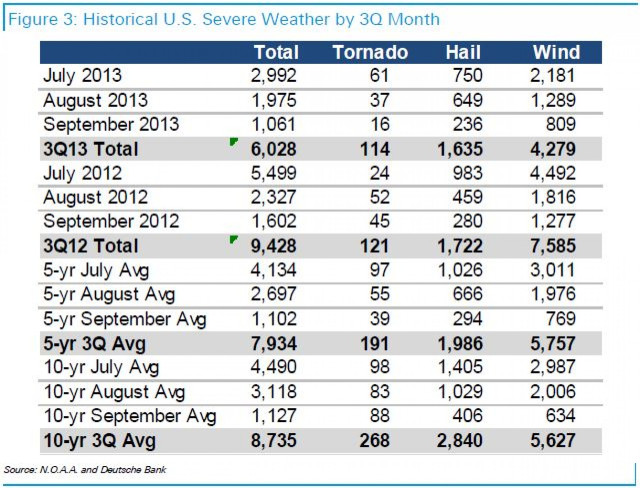American International Group Inc. (NYSE:AIG) Earnings Preview: Q3 Profit Likely To Surprise On The Upside

American International Group Inc. (NYSE:AIG), the insurer that repaid a federal goverment rescue last year, is likely to report third-quarter results that top Wall Street’s consensus estimates due to unusually favorable weather and lack of catastrophes, as well as strong equity markets that help lift investment returns and fees.
AIG is scheduled to release earnings Thursday after markets close and will host a conference call the following morning at 8 a.m. EDT.
The New York-based insurer is tipped to report net income of $1.36 billion, or 91 cents a share, on $8.63 billion in revenue, based on the average estimate of analysts surveyed by Thomson Reuters. In the same period a year earlier, net income was $1.64 billion, or $1.13 a share, on revenue of $8.75 billion. Excluding one-time items, AIG is expected to report earnings of 94 cents a share, compared with $1.00 per share in the third quarter of 2012.
AIG’s insurance operations can be divided into AIG property and casualty and AIG life and retirement. Each of these divisions account for roughly half of the company’s insurance income. Almost half of the P&C premiums come from the U.S., where AIG is the fifth-biggest insurer in direct premiums earned with a market share of 4.52 percent.
The insurance giant did not give quarterly guidance, but management is positive about where things are heading this year.
“We continue to expect modest net premium growth for the remainder of 2013 as we continue to write profitable new business,” Peter Hancock, CEO of AIG Property Casualty, told analysts on AIG’s second-quarter earnings conference call in August.
In late August, AIG agreed to accept $905 million from Canada’s largest alternative-asset manager, Brookfield Asset Management Inc. (NYSE:BAM), to resolve a dispute tied to interest-rate swaps.
JPMorgan’s Jimmy Bhullar doesn’t expect this development to affect reported EPS as the cash consideration received was already recorded as an asset on the balance sheet.
Favorable Weather Conditions
Heading into hurricane season, which runs from June 1 through Nov. 30, predictions appeared to indicate an extremely active level. For example, the National Oceanic and Atmospheric Administration forecast that seven to 11 hurricanes would form.
According to Deutsche Bank analyst Joshua Shanker, in an average year, there would have been eight tropical storms and four hurricanes (one of which would be “major” – category 3 or higher). But through Sept. 30, there were 10 tropical storms and two hurricanes (neither of which was “major”).
“Broadening the outlook of weather events, the total number of severe U.S. weather events in the third quarter of this year was down materially as compared with both the year-ago period and historical periods,” Shanker said in a note to clients.

While there have been a few notable weather events in the third quarter, given the nature and location of these events, Shanker anticipates that the implications will be less concentrated in insured losses and more likely carried by government programs.
Strong Investment Returns
The stock market fared much more favorably for investment performance in the third quarter as compared with the April-June period, especially in the outlook for book value growth.
The S&P 500 (INDEXSP:.INX) advanced 5 percent in the third quarter and should result in a slight benefit to earnings.
“A rise in equity markets tends to result in higher assets under management and account values, and increased fee revenues for life insurers with variable annuity and asset management businesses,” Jay Gelb, a Barclays analyst, wrote in an Oct. 2 note. He has an overweight rating on AIG and a price target of $56.
Additionally, alternative investments should have several periods of improving results given their correlation to equity markets and being reported on a delay.
Analysts at JPMorgan led by Bhullar expect spreads in most of AIG’s interest-sensitive products to remain healthy due to strong variable investment income and proactive crediting rate reductions by management. The company reports private equity income on a one-quarter lag and hedge fund returns on a one-month lag. Given recent capital market trends, private equity and hedge fund returns should be relatively healthy in the near term, the analyst said.
Stock Performance
The government rescued AIG from the brink of bankruptcy in September 2008, at a price tag that exceeded $182 billion. Over the past few years, AIG made significant progress in de-risking the company and was able to orchestrate a complete exit in 2012 from U.S. government ownership.
AIG announced a 10 cent per-share dividend following second-quarter results -- its first payout since it received bailout money from the government -- as well as a $1 billion share repurchase plan.
“We believe that AIG’s quarter essentially depends on the degree of share repurchase done in the third quarter,” Shanker said.
This is small relative to AIG’s long-term goal of returning $25 billion to 30 billion to shareholders over a five-year period ending in 2015. However, it may be the case that AIG’s authorization only speaks to its short-term capital return intentions.
“If AIG did, in fact, utilize much of the authorization in the third quarter … we expect the stock will respond very favorably,” Shanker added.
One of AIG's main competitors in the insurance industry is the Travelers Companies Inc. (NYSE:TRV). Other competitors in the sector include Hartford Financial Services (NYSE:HIG), HCC Insurance Holdings Inc. (NYSE:HCC) and American Financial Group (NYSE:AFG).
AIG closed up 1.6 percent, or 82 cents, to $52.25 a share, in Tuesday’s session. So far this year, the stock has gained 48 percent.
© Copyright IBTimes 2024. All rights reserved.





















